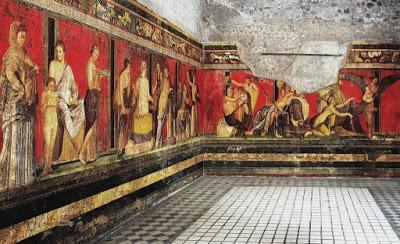
1. Villa of the Mysteries
Located on the outskirts of Pompeii, the Villa of Mysteries was once a grand Roman villa that housed over 60 rooms and covered an area of 60,000 square feet. It was discovered in 1809 and remains one of the more popular villas to see in Pompeii due to its impressive number of frescoes and grandeur. The most extraordinary fresco that you will see is one that depicts a worshipper being initiated into the cult of Dionysus, the God of wine. The fresco is a prime example of Ancient art and its vividly red background has earned the dining area the title of the iconic ‘The Red Room’.
2. Amphitheatre
The amphitheater located in Pompeii is the oldest surviving in the world with a history that pre dates back at least 20,000 years. It was the base model for all amphitheatres that followed and could hold 12,000 spectators from Pompeii and other nearby towns. Primarily used for gladiatorial battles and re-enacting plays, the story of the amphitheater is quite colourful. At one point in time, the crazed Emperor Nero banned games there for a period of 10 years after a riot broke out in the stadium. Today, you can walk the tunnels of this imposing structure and the grounds marvelling at its spacious and well thought out design. We recommend visiting this site first thing in the morning or in the late afternoon when there’s a significantly smaller number of people there.
3. House of the Faun
This house is regarded as the grandest of all in Pompeii, once housing the richest residence of the city. It spans an entire city block and is named after a bronze statue of a faun that could be seen in the front atrium. The excavations in 1831 led to the discovery of stunning frescoes which can still be seen today. Prepare to be blown away by the sheer size of the house, and let your imagination take you to the glory days of Pompeii to realize what this place must have been like. The House of Faun is also the birthplace of some of Pompeii’s most prized frescoes, some of which that can be seen in the house and others that were moved to the Archaeological Museum of Naples for further preservation.
4. Lupanar
One of the most iconic and memorable sites that you will come across on your day trip to Pompeii is the Lupanar, a purpose-built brothel in the heart of the city. Derived from the Latin term ‘wolf’s den’, this structure is one of the most visited sites by tourists due to its outlandish nature. From provocative advertisements that lined the walls, to the stone beds surrounded by graffiti from ancient customers, the two-story building is one of an original 25 brothels that were known to be in Pompeii.
5. Garden of Fugitives
In Ancient times, a traditional Pompeiian vineyard stood in a place that is now filled with a harsh reality of the power of nature’s destructions. Thirteen victims were found frozen in time, their mission to flee the city cut horribly short. Now, all that remains are the plaster casts made on the site of the last resting place for the Pompeii residents. The human casts are protected behind a glass window for curious tourists who come daily to visit the site. The area does get crowded, especially by tour groups, so make this your first stop when you arrive in Pompeii for a more closer and undisturbed viewing.

